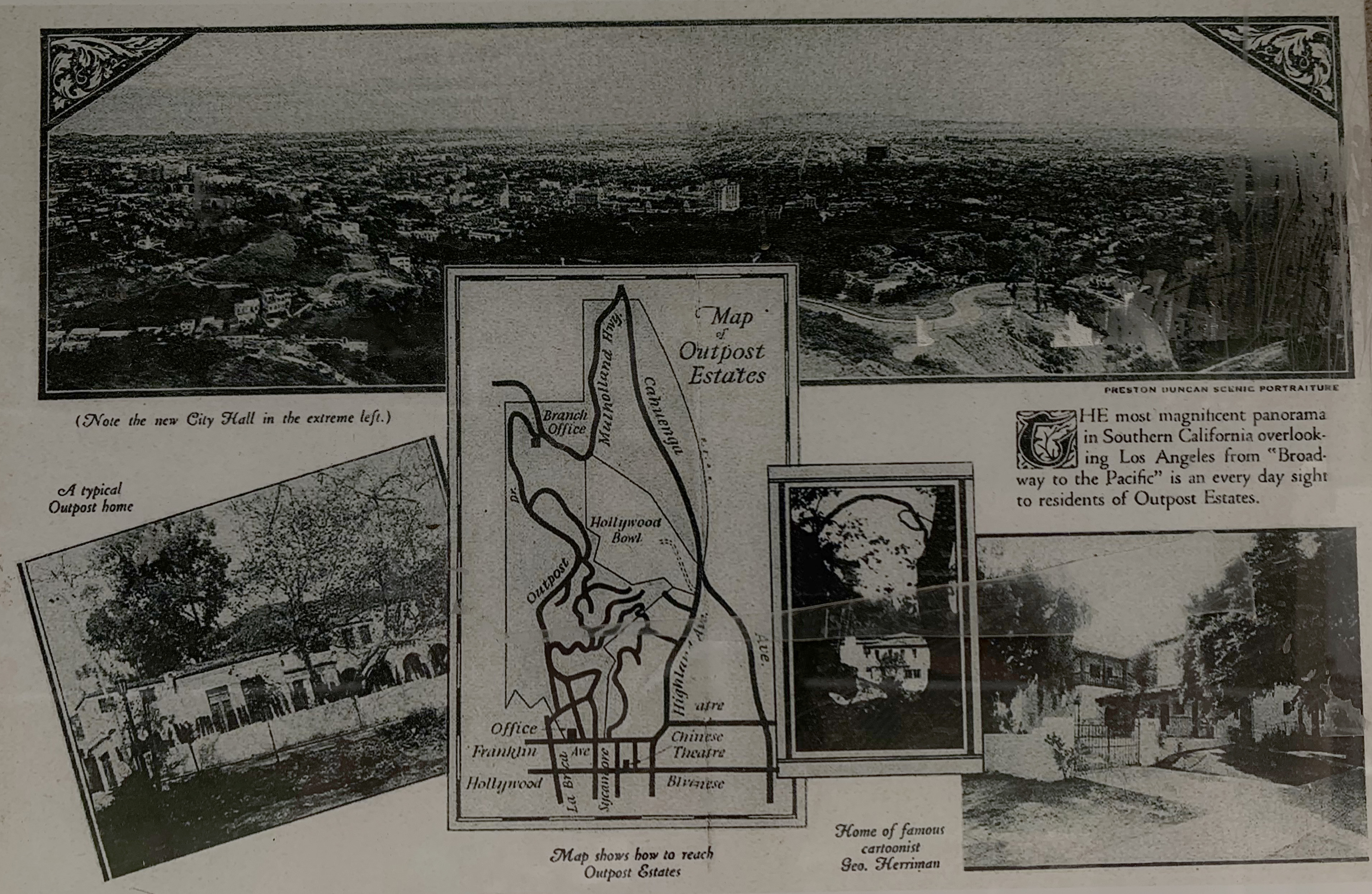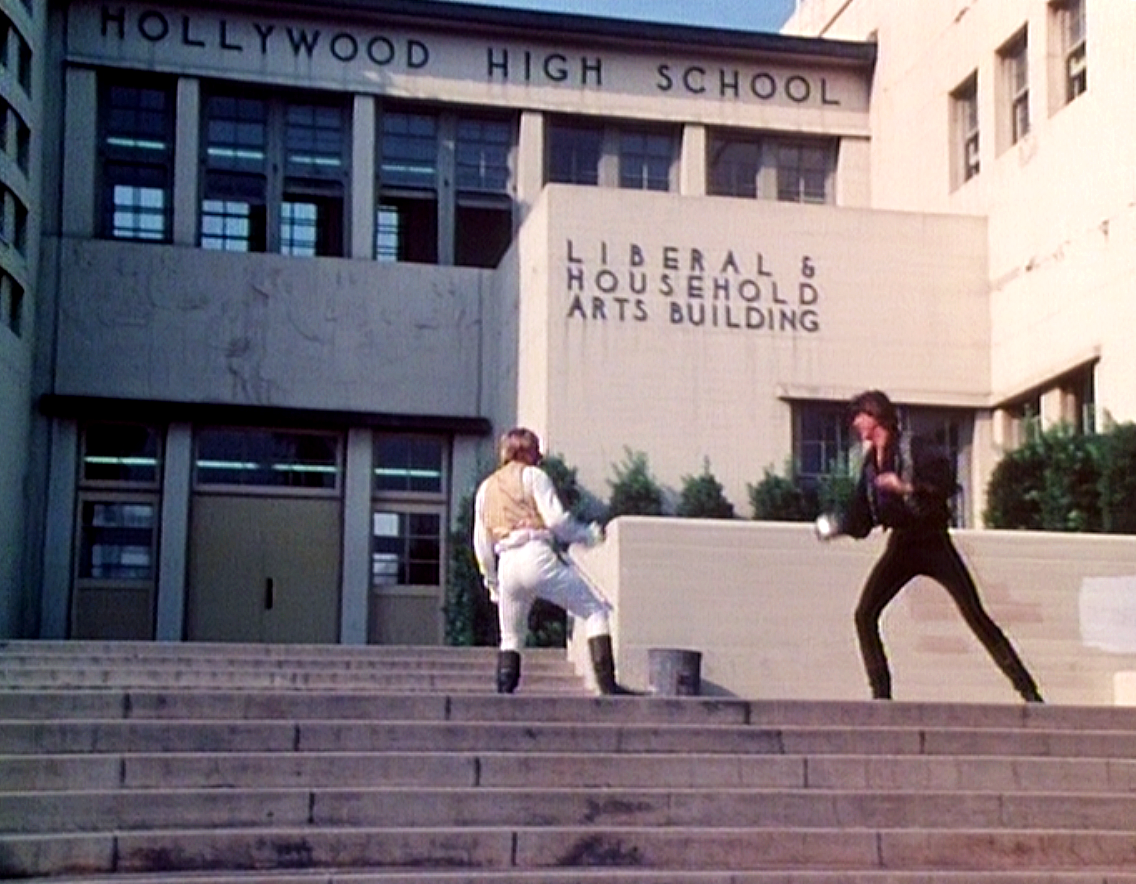|
Outpost Estates, Los Angeles
Outpost Estates is a neighborhood in the Hollywood Hills of Los Angeles, California, consisting of about 450 homes. It is bordered by Mulholland Drive to the north, Franklin Avenue to the south, Runyon Canyon Park to the west, and Hollywood Heights and the Hollywood Bowl to the east. History According to Edwin O. Palmer in his 1937 two volume ''History of Hollywood'', the area identified as Outpost Estates was one of the villages of the Native American Tongva (or Kizh) Nation (named "Gabrielino" by the Spanish after their Mission San Gabriel Arcángel). The Tongva people, who speak a Uto-Aztecan language and are affiliated to the Shoshone people of Western America, have occupied the area for at least 3500 years, and were preceded in the area by Hokan-speaking native people. Based on the 1852 letters of Hugo Reid and other sources, Palmer wrote: "...the rolling hills, deep canyons, and gentle slopes now called Hollywood, were known by their inhabitants as Cahuegna (little ... [...More Info...] [...Related Items...] OR: [Wikipedia] [Google] [Baidu] |
Hollywood Hills
The Hollywood Hills is a residential neighborhood in the central region of Los Angeles, California. It borders Studio City, Universal City and Burbank on the north, Griffith Park on the north and east, Los Feliz on the southeast, Hollywood on the south and Hollywood Hills West on the west. It includes Forest Lawn Memorial Park, Mount Sinai Memorial Park Cemetery, the Hollywood Reservoir, the Hollywood Sign, the Hollywood Bowl and the John Anson Ford Theater.''The Thomas Guide,'' 2006, pages 563 and 593 Geography The Hollywood Hills straddle the Cahuenga Pass within the Santa Monica Mountains. It is bisected southeast–northwest by US 101. The neighborhood is bounded on the northwest and north by the Los Angeles city line, on the east by a fireroad through Griffith Park, continuing on Western Avenue, on the south by Franklin Avenue and on the west by an irregular line that includes Outpost Drive. Bedrock of the Hills is a complex association of granitic ... [...More Info...] [...Related Items...] OR: [Wikipedia] [Google] [Baidu] |
Adobe
Adobe (from arabic: الطوب Attub ; ) is a building material made from earth and organic materials. is Spanish for mudbrick. In some English-speaking regions of Spanish heritage, such as the Southwestern United States, the term is used to refer to any kind of earthen construction, or various architectural styles like Pueblo Revival or Territorial Revival. Most adobe buildings are similar in appearance to cob and rammed earth buildings. Adobe is among the earliest building materials, and is used throughout the world. Adobe architecture has been dated to before 5,100 BP. Description Adobe bricks are rectangular prisms small enough that they can quickly air dry individually without cracking. They can be subsequently assembled, with the application of adobe mud to bond the individual bricks into a structure. There is no standard size, with substantial variations over the years and in different regions. In some areas a popular size measured weighing about ; in other ... [...More Info...] [...Related Items...] OR: [Wikipedia] [Google] [Baidu] |
Neighborhoods In Hollywood, Los Angeles
A neighbourhood (Commonwealth English) or neighborhood (American English) is a geographically localized community within a larger town, city, suburb or rural area, sometimes consisting of a single street and the buildings lining it. Neighbourhoods are often social communities with considerable face-to-face interaction among members. Researchers have not agreed on an exact definition, but the following may serve as a starting point: "Neighbourhood is generally defined spatially as a specific geographic area and functionally as a set of social networks. Neighbourhoods, then, are the spatial units in which face-to-face social interactions occur—the personal settings and situations where residents seek to realise common values, socialise youth, and maintain effective social control." Preindustrial cities In the words of the urban scholar Lewis Mumford, "Neighborhoods, in some annoying, inchoate fashion exist wherever human beings congregate, in permanent family dwellings; and ma ... [...More Info...] [...Related Items...] OR: [Wikipedia] [Google] [Baidu] |
Neighborhoods In Los Angeles
This is a list of notable districts and neighborhoods within the city of Los Angeles in the U.S. state of California, present and past. It includes residential and commercial industrial areas, historic preservation zones, and business-improvement districts, but does not include sales subdivisions, tract names, homeowners associations, and informal names for areas. Regions Current districts and neighborhoods AE * Angelino Heights, Los Angeles, Angelino Heights''The Thomas Guide: Los Angeles County'', Rand McNally (2004), pages N and O * Angeles Mesa, Los Angeles, Angeles Mesa * Angelus Vista, Los Angeles, Angelus Vista * Annandale, California, Annandale (partially in Pasadena) * Arleta, Los Angeles, ArletaNeighborhoods , Mapping L.A., ''Los Angeles Times'' * Arlington Heights, Los Angeles, Arlington Heights [...More Info...] [...Related Items...] OR: [Wikipedia] [Google] [Baidu] |
Hollywood High School
Hollywood High School is a four-year public secondary school in the Los Angeles Unified School District, located at the intersection of North Highland Avenue and West Sunset Boulevard in the Hollywood district of Los Angeles, California. History In September 1903, a two-room school was opened on the second floor of an empty storeroom at the Masonic Temple on Highland Avenue, north of Hollywood Boulevard (then Prospect Avenue). Hollywood was incorporated as a municipality in November 1903. The Hollywood High Organ Opus 481 was a gift from the class of 1924. After suffering severe water damage from the Northridge earthquake in 1994, it was restored in 2002. The campus was listed on the National Register of Historic Places on January 4, 2012. The school's mascot was derived from the 1921 Rudolph Valentino film of the same name, '' The Sheik''. It was in the Los Angeles City High School District until 1961, when it merged into LAUSD. In the 2015–16 football season, the boy ... [...More Info...] [...Related Items...] OR: [Wikipedia] [Google] [Baidu] |
Huell Howser
Huell Burnley Howser (October 18, 1945 – January 7, 2013) was an American television personality, actor, producer, writer, singer, and voice artist, best known for hosting, producing, and writing ''California's Gold'' and his human interest show ''Visiting... with Huell Howser'', produced by KCET in Los Angeles for California PBS stations. The archive of his video chronicles offers an enhanced understanding of the history, culture, and people of California. He also voiced the Backson in ''Winnie the Pooh (2011 film), Winnie the Pooh'' (2011). Early life Howser was born in Gallatin, Tennessee, on October 18, 1945, to Harold Chamberlain and Jewell Havens (Burnley) Howser. Howser's first name is a portmanteau of his parents' given names, Harold and Jewell, as Howser explained in the ''California's Gold'' episode "Smartsville." Howser graduated from the University School of Nashville in 1963, then studied history and political science at the University of Tennessee, where he serve ... [...More Info...] [...Related Items...] OR: [Wikipedia] [Google] [Baidu] |
California's Gold
''California's Gold'' was a public television human interest program that explores the natural, cultural, and historical features of California. The series ran for 24 seasons beginning in 1991, and was produced and hosted by Huell Howser in collaboration with KCET, Los Angeles. The series ceased production when Howser retired in November 2012, shortly before his death on January 7, 2013, although episodes continue to be shown on KCET and are featured on the page at the station's website about his shows. The series theme song is " California, Here I Come". Typically, it is performed by local musicians who may be from a given episode's locale. However, some episodes include an old-time recording of the California state song " I Love You, California". Production The minimal production allowed locations and people to remain the focal point of the program. Howser's archives are now housed at Chapman University in Orange, California, and can be streamed online. The decision to donat ... [...More Info...] [...Related Items...] OR: [Wikipedia] [Google] [Baidu] |
Charles E
Charles is a masculine given name predominantly found in English language, English and French language, French speaking countries. It is from the French form ''Charles'' of the Proto-Germanic, Proto-Germanic name (in runic alphabet) or ''*karilaz'' (in Latin alphabet), whose meaning was "free man". The Old English descendant of this word was ''Churl, Ċearl'' or ''Ċeorl'', as the name of King Cearl of Mercia, that disappeared after the Norman conquest of England. The name was notably borne by Charlemagne (Charles the Great), and was at the time Latinisation of names, Latinized as ''Karolus'' (as in ''Vita Karoli Magni''), later also as ''Carolus (other), Carolus''. Etymology The name's etymology is a Common Germanic noun ''*karilaz'' meaning "free man", which survives in English as wikt:churl, churl (< Old English ''ċeorl''), which developed its deprecating sense in the Middle English period. Some Germanic languages, for example Dutch language, Dutch and German ... [...More Info...] [...Related Items...] OR: [Wikipedia] [Google] [Baidu] |
Outpost Estates Brochure
Outpost or outposts may refer to: Places * Outpost (military), a detachment of troops stationed at a distance from the main force or formation, usually at a station in a remote or sparsely populated location * Border outpost, an outpost maintained by a sovereign state on its border, usually one of a series placed at regular intervals, to watch over and safeguard its border with a neighboring state * Human outpost, an artificially-created, controlled human habitat located in an environment inhospitable for humans, such as the ocean floor, the Antarctic, in space, or on another planet * Outpost Estates, Los Angeles, California, a canyon neighborhood * Outpost Islands, Nunavut, Canada * Israeli outpost, a settlement built on land that was not legally purchased and was not given a building permit by the State of Israel Entertainment * ''The Outpost'', a 1909 play written by James Francis Jewell Archibald * ''Outpost'' (board game), from TimJim games * Outpost (chess), a strate ... [...More Info...] [...Related Items...] OR: [Wikipedia] [Google] [Baidu] |
Los Angeles Times
The ''Los Angeles Times'' is an American Newspaper#Daily, daily newspaper that began publishing in Los Angeles, California, in 1881. Based in the Greater Los Angeles city of El Segundo, California, El Segundo since 2018, it is the List of newspapers in the United States, sixth-largest newspaper in the U.S. and the largest in the Western United States with a print circulation of 118,760. It has 500,000 online subscribers, the fifth-largest among U.S. newspapers. Owned by Patrick Soon-Shiong and published by California Times, the paper has won over 40 Pulitzer Prizes since its founding. In the 19th century, the paper developed a reputation for civic boosterism and opposition to Trade union, labor unions, the latter of which led to the Los Angeles Times bombing, bombing of its headquarters in 1910. The paper's profile grew substantially in the 1960s under publisher Otis Chandler, who adopted a more national focus. As with other regional newspapers in California and the United Sta ... [...More Info...] [...Related Items...] OR: [Wikipedia] [Google] [Baidu] |
Harrison Gray Otis (publisher)
Harrison Gray Otis (February 10, 1837 – July 30, 1917) was a Union Army officer during the American Civil War who later became president and general manager of the Times Mirror Company, then the publisher of the ''Los Angeles Times''. Biography Early life and education Otis was born near Marietta, Ohio, on February 10, 1837, the son of Stephen and Sally (Dyar) Otis. His father was from Vermont and his mother, a native of Nova Scotia, Canada, came to Ohio from Boston, Massachusetts, with her family. The young Otis received schooling until he was fourteen, when he became a printer's apprentice at the ''Noble County Courier'' in Ohio. Career Otis was a delegate from Kentucky to the Republican National Convention that nominated Abraham Lincoln for president in 1860. Civil War At the outbreak of the American Civil War in 1861, he left his job as a compositor in the office of the '' Louisville Journal'' to volunteer as a private for the Union army. Otis enlisted as a Sergeant ... [...More Info...] [...Related Items...] OR: [Wikipedia] [Google] [Baidu] |

